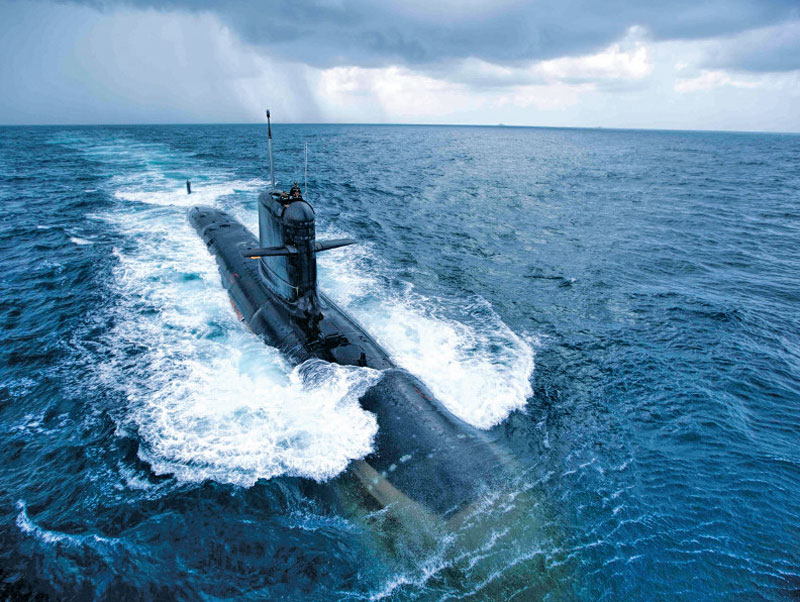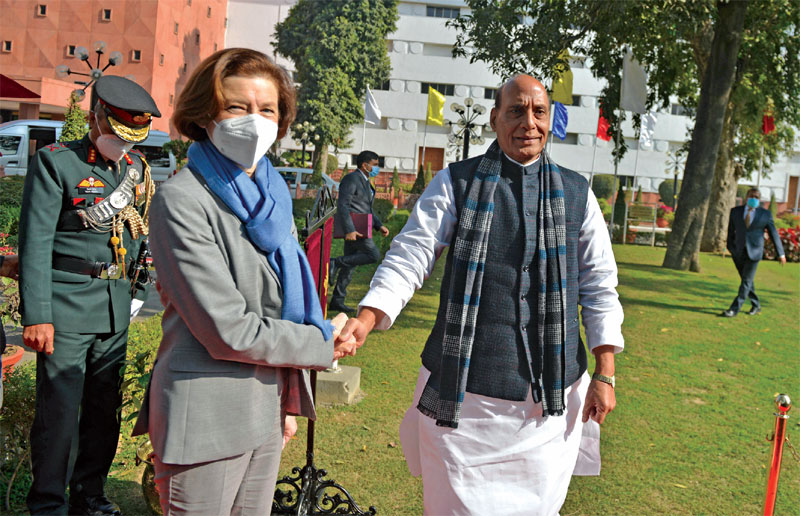Deepening maritime ties between India and France yet to fructify into procurement by the Indian Navy
Atul Chandra
Despite India and France having been strategic partners since for nearly a quarter of a century, the strong ties have not resulted in the acquisition of sophisticated French naval equipment for the Indian Navy (IN).
The Project 75 (P-75) programme for manufacture of Scorpene submarines is the sole major success for the French in this arena. The IN, which has championed indigenisation in warship procurement, relies mainly on Russian warships or warships of Indian design with Russian and Israeli weapons and sensors. This is indeed surprising, considering that French naval equipment are widely considered to be highly capable. The lack of acquisition of major French naval equipment by IN is in stark contrast with the Indian Air Force (IAF), which has continued to induct advanced French fighters since the mid-1980s.

Enduring Partnership
India and France established a strategic partnership in 1998 in defence & security cooperation, space cooperation and civil nuclear cooperation. Florence Parly, minister for the armed forces of France, has made official visits to India on a number of occasions since her first visit in 2017. One of her very first official trips since the outbreak of the Covid-19 epidemic was to India.
During his recent visit to France, Prime Minister Narendra Modi met with French President Emmanuel Macron. The India–France joint statement issued during the PM’s visit to France welcomed the ongoing intense cooperation across all defence domains. Joint exercises (Shakti, Varuna, Pegase, Desert Knight, Garuda) were aimed at better integration and interoperability. ‘Maritime cooperation between India and France has reached new levels of trust and will continue through exercises, exchanges and joint endeavours throughout the Indian Ocean,’ read the statement. ‘Taking forward this momentum, and based on their mutual trust, both sides agreed to find creative ways for France’s deeper involvement in “Aatmanirbhar Bharat” efforts in advanced defence technology, manufacturing and exports, including increased industry to industry partnerships.’
The French defence minister has also been a regular visitor to India and her most recent official visit to India was in December 2021, where in addition to calling on Prime Minister Modi, she took part in the Annual Defence Dialogue with defence minister Rajnath Singh. The in-depth talks covered all aspects of the wide-ranging Indo-French defence cooperation, including operational defence cooperation, particularly maritime security in the Indo-Pacific; industrial and technological partnership in line with Make in India; and counter-terrorism cooperation. The first edition of the Annual Defence Dialogue took place in October 2018.
Parly was also present at the official induction ceremony of the first batch of the Rafale fighter aircraft AFS Ambala in September 2020. Since the Modi government has been in power, both nations have worked to further deepen and expand the Indo-French partnership, with strategic autonomy and the defence of a multipolar order as their cornerstones. Speaking at the Rafale induction ceremony at Ambala, Parly said that both nations shared a commonality of interests, vision and values in the region—a common attachment to democracy, multilateralism and rules-based order. “It takes a lot of confidence for India, to bet on France; and a lot of confidence, too, for France, to share with India a capability that is so close to the core of our sovereignty and our strategic autonomy—the result of immense investments over decades,” said Parly. Both nations held several major bilateral air, navy, and army exercises last year: Desert Knight 21 in January, Varuna in April, Shakti in November.
Trade between both nations have remained buoyant dispute the pandemic. Franco-Indian trade slowed in 2020, to Euros 9 billion as against Euros 11.5 billion in 2019, largely due to the impact of the COVID-19 pandemic. France is the 7th largest foreign investor in India, with foreign direct investment stock of Euros 9 billion between April 2000 to December 2020. In the period April 2018-March 2019, India-France bilateral trade stood at Euros 11.59 billion, India’s exports to France were valued at Euros 6.23 billion while, French exports to India stood at Euros 5.35 billion. There are more than 540 subsidiaries of French companies present in the country. A significant portion of French exports to India cover aviation, chemical and pharmaceutical industries, along with communications equipment.
Despite such a strong industrial presence in India, French firms have been unable to become major partners for Indian naval programmes. The quantity of French supplied equipment on the navy’s advanced P-15B Visakhapatnam class Destroyers and P-17A Nilgiri class stealth frigates is not publicly available. However, whatever information currently is available indicates that these are not in significant quantities. The same would be the case for the Delhi and Kolkata Class Destroyers and Shivalik Stealth Frigates.

Need for Growth
While the long-standing armament cooperation between India and France is testimony to the mutual trust between the two sides, it has resulted in precious little for the latter in terms of orders for naval equipment apart from the manufacture of six Scorpene submarines built at Mazagon Docks Limited (MDL) in Mumbai.
India had ordered six ‘Kalvari’ class submarines in 2005. The IN has presently commissioned four Scorpene submarines into service—Kalvari, Khanderi, Karanj and Vela, while the 5th, Vagir, is undergoing sea trials. The sixth Scorpene submarine Vagsheer is soon to commence harbour trials. Including Indian orders for six submarines, Naval Group has sold another eight of the conventional attack submarines (SSK) to export customers. The 2,000 tonne SSK has six weapon launching tubes and can carry 18 weapons such as torpedoes and missiles.
MDL received the first Indian made equipment for the Scorpene submarines in February 2012. Naval Group (then known as DCNS) had signed a contract with Indian firm Flash Forge India in June 2011 for supply of equipment for the Scorpene. The Factory Acceptance Test (FAT) for the first locally made Scorpenes’ equipment (for the largescale piping system) was successfully performed at Flash Forge premises in Vishakhapatnam in January 2012.
In May, Naval Group announced its inability to participate in the navy’s highly anticipated P-75I programme, to build six follow-on submarines to the Scorpene Class. Naval Group stated that it was exiting the competition due to the requirement for a sea proven Air Independent Propulsion (AIP) system, which Naval Group does not possess. Naval Group’s departure from the Rs 43,000 crore P-75I programme is a major setback to navy’s plans to acquire more submarines. The MoD had issued Request for Proposals (RFP) to Larsen & Toubro (L&T) and MDL as Strategic Partners (SP). The two companies would have had to partner with short listed companies such as Naval Group (France), ThyssenKrupp Marine Systems (Germany), Navantia (Spain), Daewoo (South Korea) and Russia’s Rosoboronexport. Saab of Sweden had pulled out from the competition in 2019.
However, as of now, there is uncertainty about the programme, as except for Daewoo, all participants have expressed their inability to meet the current RFI conditions.

New Sonars
In April, Thales announced that it had signed a contract with Lockheed Martin as a tier-one supplier for the delivery of up to 55 airborne anti-submarine warfare sonars. The Airborne Low Frequency Sonar (ALFS) dipping sonars will be installed on the MH-60R platform for the US Navy and three navies. The navies of India, Greece and Denmark will receive the helicopter dipping sonars through US foreign military sales of the MH-60R.
“Earning the trust of the US Navy and its allies and partners around the globe is a source of pride for our team. This contract enhances our position as a strategic supplier to Lockheed Martin and further consolidates the Group’s world leadership position in anti-submarine warfare systems. We will continue to improve the performance and competitiveness of our airborne sonars to meet the new anti-submarine warfare operational challenges of our customers.” Alexis Morel, vice president, Underwater systems, Thales.
Thales has been contracted to deliver the first 42 systems over the next five years with a delivery of 13 optional systems to occur in year six. India is said to have ordered 24 ALFS dipping sonars, of which three have already been delivered. The ALFS anti-submarine warfare system is capable of detecting, classifying, prosecuting, harassing or attacking submarines and has also been chosen by the navies of Australia, the United Kingdom, France, Norway, Sweden, the United Arab Emirates, Poland, South Korea and the Philippines.
The ALFS is a low frequency active sonar and was designed for the initial detection and tracking of opposing submarines. It offers a long detection range with a wide coverage rate and a low false alarm level, both in deep and coastal waters. It can be used autonomously to clear a particular area or as a complementary anti-submarine warfare asset to sonars on board surface vessels for target relocation and attack. The Thales ALFS and FLASH systems are from the same product family of airborne anti-submarine dipping sonars but each product has variances due to system destinations and the local technological requirements to comply with including US ITAR. Since the early 2000’s, more than 300 ALFS sonars have been delivered by Thales to the US Navy.
Preferred Partner
While India has preferred to stay largely away from the French naval industry, many other nations have embraced them with open arms. Naval Group’s Gowind Corvette is a commercial success with 12 warships already sold. Most of the warships are being built locally through transfer of technology and partnerships with local industry. The Egyptian Navy has three of the warships in service. The United Arab Emirates’ (UAE) second Gowind Corvette ‘Al Emarat’ was launched in May in Lorient, France in the presence of an official delegation from the United Arab Emirates Navy.
Stéphane Frémont, director of surface ship programmes at Naval Group, said: “The launching of Gowind Al Emarat is a major industrial and symbolic milestone, where the corvette reaches her natural environment. The two Bani Yas class vessels benefit from the modular design of the Gowind family and are the perfect asset to help the UAE Navy meet the challenges of today and tomorrow thanks to the most advanced technologies.” The UAE had ordered two Gowind Corvettes in 2019, which were to be built in France. The first corvette, Bani Yas, was launched in December 2021.
In March, Naval Group inked a contract with Greece for three Defence and Intervention Frigates (FDI HN) with an option for one more. Two FDI HN (Hellenic Navy) will be delivered in 2025 and the third one in 2026. Greece has also contracted Naval Group for MU90 torpedoes and CANTO countermeasures. Pierre Éric Pommellet, Chairman and Chief Executive Officer of Naval Group said: “Naval Group is proud, along with its French industrial partners Dassault, MBDA and Thales, to be a part of this new chapter in the strategic alliance between Greece and France. Greece has chosen the latest generation of frigates that bring together the best of French naval know-how and will strengthen the capabilities of the Hellenic Navy. The frigates program is the first of many steps in the partnership between Naval Group and the Hellenic Navy…”
The FDI HN will be fitted with Thales’ Sea Fire, the first all-digital multifunction radar with an active antenna and fixed panels and is equipped with a unique integrated mast that brings together all the airborne sensors, enabling permanent 360 degree surveillance. Naval Group also touts the FDI HN as the first frigate on the market to be natively protected against cyber threats. It is equipped with two data centres hosting almost all of the ship’s applications.

